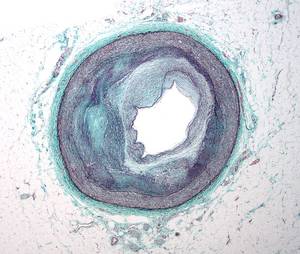An overlooked cell lurking in the walls of arteries could be the cause of the vascular disease that leads to heart attacks and strokes, new research has  revealed.
revealed.
Writing in Nature Communications, University of California, Berkeley scientist Zhenyu Tang and his colleagues show that a previously-ignored form of stem cell, which they dub the MVSC - multipotent vascular stem cell, may be the smoking gun behind the artery-furring process of atherosclerosis.
Prior to now, scientists had believed that, in response to injury to the inner lining of a blood vessel by factors such as diabetes, smoking or high blood pressure, the smooth muscle cells that form a circulate coat around the vessel begin to proliferate, forming a bulge that slowly blocks the artery.
But when Tang and his team used a range of chemical markers to examine the features of the cells present in the walls of arteries and veins they found a small population of non-muscle cells hiding amongst the muscle.
These cells, they found, show all the signs of being stem cells capable of producing a raft of different tissue types, including even bone, nerve-supporting cells and cartilage. And when they made injuries in vessels in experimental animals, the team found that in fact these stem cells were the ones that were proliferating and producing the artery-blocking bulges that characterise patches of atheroma.
The stem cells were probably overlooked before, the team speculate, because they also produce new muscle cells so when researchers had examined artery specimens in the past and seen proliferations of muscle they concluded that the muscle itself must be responsible.
The discovery of these MVSCs, which, critically, are also present in human arteries, could open the door to a range of new approaches to better managing arterial disease and may explain a host of vascular pathologies, including, given their preponderance to turn into bone cells, the calcifications that characterise some vascular lesions.










Comments
Add a comment